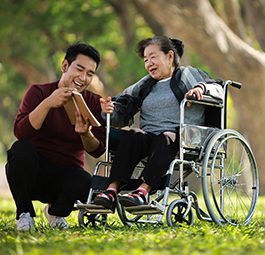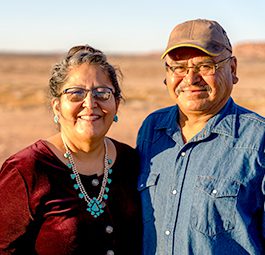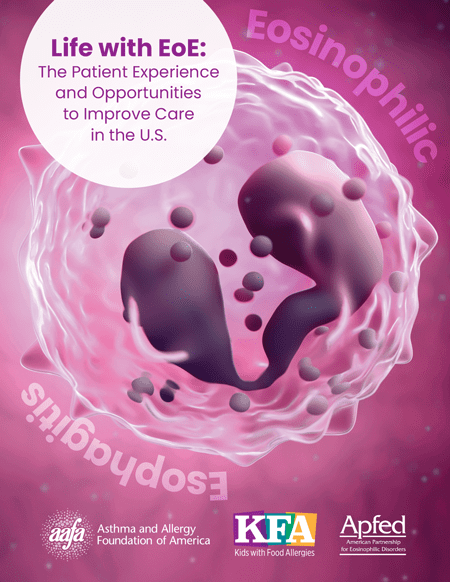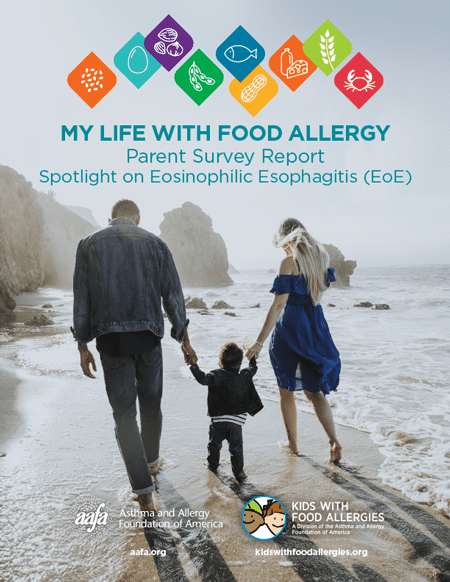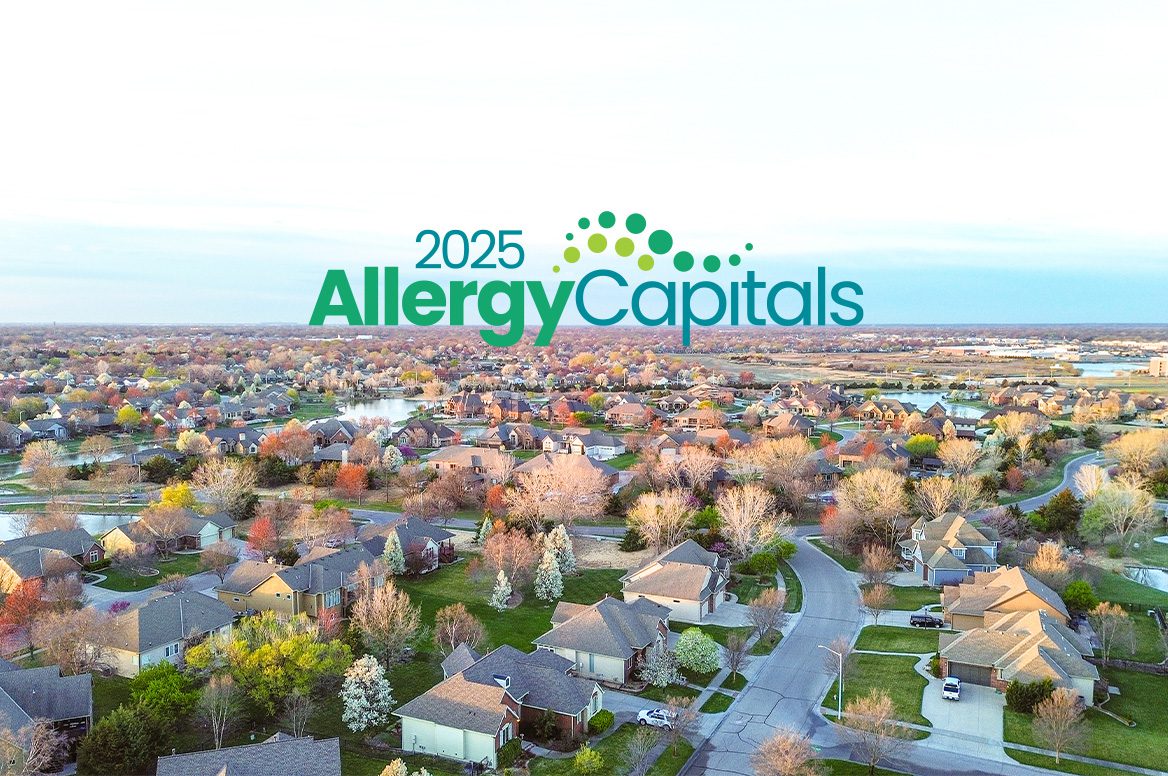Research and Reports
Life with Eosinophilic Esophagitis (EoE)
Eosinophilic esophagitis (EoE) is a chronic inflammatory condition of the esophagus (the tube that connects the mouth to the stomach). It is characterized by excessive numbers of eosinophils, a type of white blood cell, that accumulate in the esophagus in response to a trigger (often food or pollen). EoE can cause difficulty swallowing, food impactions (where food gets stuck in the throat), nausea, vomiting, reflux, stomach and chest pain, malnutrition, and weight loss.
The rates of EoE continue to rise significantly in the U.S. and around the world. The landscape of EoE care in the U.S. is evolving.
The Asthma and Allergy Foundation of America (AAFA) and the American Partnership for Eosinophilic Disorders (APFED) conducted a multicomponent cross-sectional needs assessment study for EoE. The study aimed to understand the patient journey for EoE as well as health care providers’ awareness of and practice around EoE. Results from the study are published in a new report titled Life with EoE: The Patient Experience and Opportunities to Improve Care in the U.S.
About the Study
This study included four components:
- Social listening
- One-on-one interviews with patients and caregivers
- Survey of patients and caregivers
- Survey of health care providers (HCPs)
The study sought to better understand current challenges and barriers to timely diagnosis, quality medical care, effective treatments, and access to resources for EoE. The objectives of the study were to:
- Understand the current state of EoE care in the U.S.
- Understand the patient journey for EoE
- Understand health care providers’ awareness of and practice around EoE
- Identify unmet needs for EoE patients and family members
- Identify unmet needs for health care providers caring for EoE patients
The Life with EoE report uses insights from the interviews (n=7), patient/caregiver survey (n=160) and HCP survey (n=110) to identify and provide opportunities for improving EoE care in the United States.
Key Findings
Many patients experience delays in diagnosis for EoE, leading to delayed symptom relief, clinical care, and treatment.
- The majority of patients/caregivers (53%) said it took a year or more for them to receive an EoE diagnosis, including 14% who indicated it took more than 10 years to get diagnosed.
- Challenges to timely and accurate diagnosis include having to see multiple doctors before finding one knowledgeable in EoE, experiencing initial misdiagnoses, not recognizing symptoms as indicative of an underlying condition, and doctors dismissing symptoms.
- The majority (87%) of non-GI HCPs reported that non-responsiveness to PPI would prompt referral to a GI specialist for diagnosis of EoE (contradicting updated consensus recommendation to remove PPI as a diagnostic tool).
Signs and symptoms of EoE are not well-understood and mimic many other diseases, further delaying EoE diagnosis.
- The most challenging symptoms reported by patients vary significantly by age.
- Lack of awareness of EoE symptoms among patients/caregivers and HCPs is a key driver of delayed diagnosis.
- HCPs reported that the most common reason for delayed diagnosis is that patients learn to cope with symptoms (64%).
Multidisciplinary care teams are common for EoE management.
- Patients/caregivers see multiple HCPs for EoE; four in five (81%) reported seeing a GI doctor, three in five (62%) reported seeing an allergist/immunologist, and two in five (38%) reported seeing a PCP.
- Two thirds of patients/caregivers reported seeing more than one type of doctor for EoE; one in eight (13%) reported seeing four or more doctors for EoE. Children were more likely than adults to see multiple doctors for EoE.
- HCPs reported high levels of collaboration between GI doctors, allergists/immunologists, PCPs, and dietitians/nutritionists.
Limited options in FDA-approved treatments for EoE lead to frustration and challenges.
- Elimination diets, PPI, and topical steroids were commonly-reported treatments for EoE, but patients/caregivers and HCPs reported concerns and challenges with all treatments.
- Efficacy, side effects, and doctor recommendation were reported as the three most important factors for patients/caregivers when choosing a treatment option.
- Though patient/caregiver awareness of emerging treatments was low, patients/caregivers said they are likely to participate in clinical trials if asked.
- Though biologics are a new treatment option for EoE, patients/caregivers who have tried a biologic report high utility of treatment.
Adherence to treatment plans—particularly dietary therapies—poses the greatest challenge in managing EoE.
- Nearly two thirds (64%) of patients/caregivers indicated diet management as one of the biggest challenges in managing EoE. Two in five (38%) cited the effectiveness of care and treatment as challenges.
- HCPs reported patient adherence to treatment plans as the biggest challenge with EoE management; with reported adherence to dietary therapy significantly lower than pharmacological treatment.
- Other reported challenges were related to financial impact, such as the cost of treatment, formula, and specialty food, as well as issues with insurance coverage for EoE treatments.
EoE has a significant impact on social and emotional well-being.
- Patients/caregivers reported a sense of “mourning” following diagnosis related to the impact of EoE on diet, eating habits, and social activities.
- Patients reported that EoE has a high impact on emotional health (35%) and social life (34%). Caregivers and HCPs reported higher perceived impact on patients.
- The majority (66%) of HCPs reported that their patients with EoE typically experience anxiety and/or depression more than once a year.
Patients/caregivers and HCPs acknowledge a greater need for support and resources for EoE.
- Patients/caregivers were dissatisfied with general awareness of EoE (57%), financial resources to support medical care (51%), and social and emotional support (43%).
- Patients/caregivers expressed a need for comprehensive resources that cover everything from symptoms to treatment options. They also stressed the need for resources to manage EoE at various stages of the patient journey.
- HCPs were dissatisfied with the availability of insurance reimbursable expenses for patient diagnostics or treatments (37%), awareness/education of EoE among other HCPs (35%), and availability of knowledgeable ancillary service providers such as dietitians and psychologists (30%).
- HCPs expressed a need for better educational materials to provide patients with EoE.
Unmet Needs and Opportunities to Improve Care
This report provides an overview of the EoE journey from the patient, caregiver, and health care provider (HCP) perspectives using data gleaned from a multi-component needs assessment study. By analyzing data and common themes from the study, AAFA and APFED identified several unmet needs and areas of opportunity for improving EoE care.
The report summarizes unmet needs that emerged from the study as well as opportunities for EoE stakeholders to address needs in the following domains:
- Clinical care and HCP education
- Treatments and patient-centered research
- Patient education and public awareness
- Psychosocial support
- Advocacy and financial support
Download PDFs
Life with EoE: The Patient Experience and Opportunities to Improve Care in the U.S. (3.66 MB, 64 pages)<!–
New Study on the Current State of Health Care for Eosinophilic Esophagitis (May 18, 2023)–>
Recommended Citation
Asthma and Allergy Foundation of America and American Partnership for Eosinophilic Disorders, (2023). Life with EoE: The Patient Experience and Opportunities to Improve Care in the U.S. Retrieved from aafa.org/EoELife.
Media Inquiries
For media and related inquiries, contact gro.afaa@aidem.
Acknowledgements
Authors:
- Melanie Carver, Chief Mission Officer, AAFA
- Sanaz Eftekhari, Chief Business Development Officer, Vice President of Research, AAFA
- Hannah Jaffee, Research Manager, AAFA
- Cara Schmitt, Programs and Services Manager, APFED
- Mary Jo Strobel, Executive Director, APFED
The authors would like to acknowledge and express our appreciation to the following people for their input and guidance related to portions of the survey instruments, and/or review or design of this report:
- Joy Chang, MD, University of Michigan
- Nicole Gaghan, Art Director, AAFA
- Matthew Greenhawt, MD, Children’s Hospital Colorado
- Mark Holbreich, MD, Indianapolis, IN
- Denise Mack, Patient Advocate
- Jonathan Medernach, DO, University of Virginia
The Life with EoE report is an independent research project of the Asthma and Allergy Foundation of America and the American Partnership for Eosinophilic Disorders and made possible by support from Sanofi and Regeneron.
The views and opinions expressed in this report are those of the study participants and the AAFA and APFED authors and do not necessarily reflect the policies or positions of other individuals, organizations, or companies.
Your Guide to Managing Eosinophilic Esophagitis (EoE)
EoE can be a complex condition to manage. AAFA and our food allergy division, Kids with Food Allergies (KFA) have created a guide called “Your Guide to Managing Eosinophilic Esophagitis (EoE)” to help you understand the basics of EoE and how to manage it. This guide covers:
- What EoE is
- Signs and symptoms in infants, children, and adults
- How EoE is diagnosed
- How EoE is treated
- Ways to manage the impact of EoE on your quality of life
- How to find support
Download the guide for free.
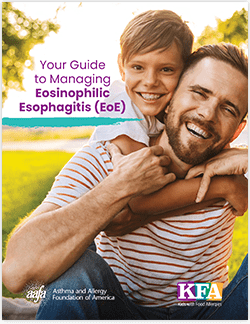 Download, print, and share Download, print, and share |  Descargar, imprimir y compartir Descargar, imprimir y compartir |





